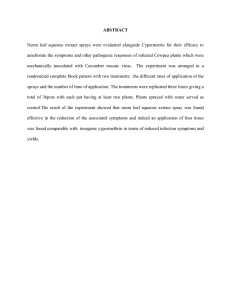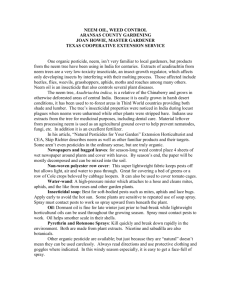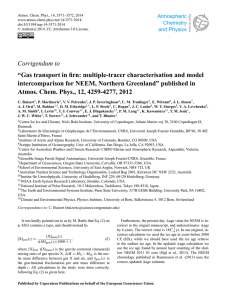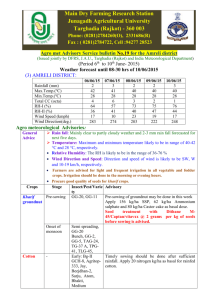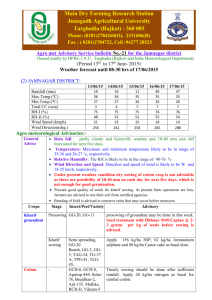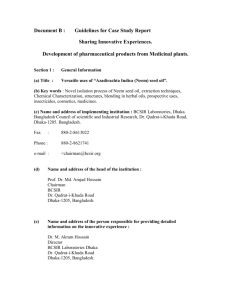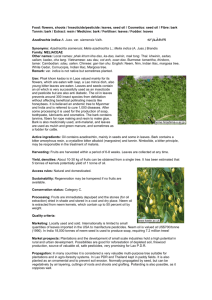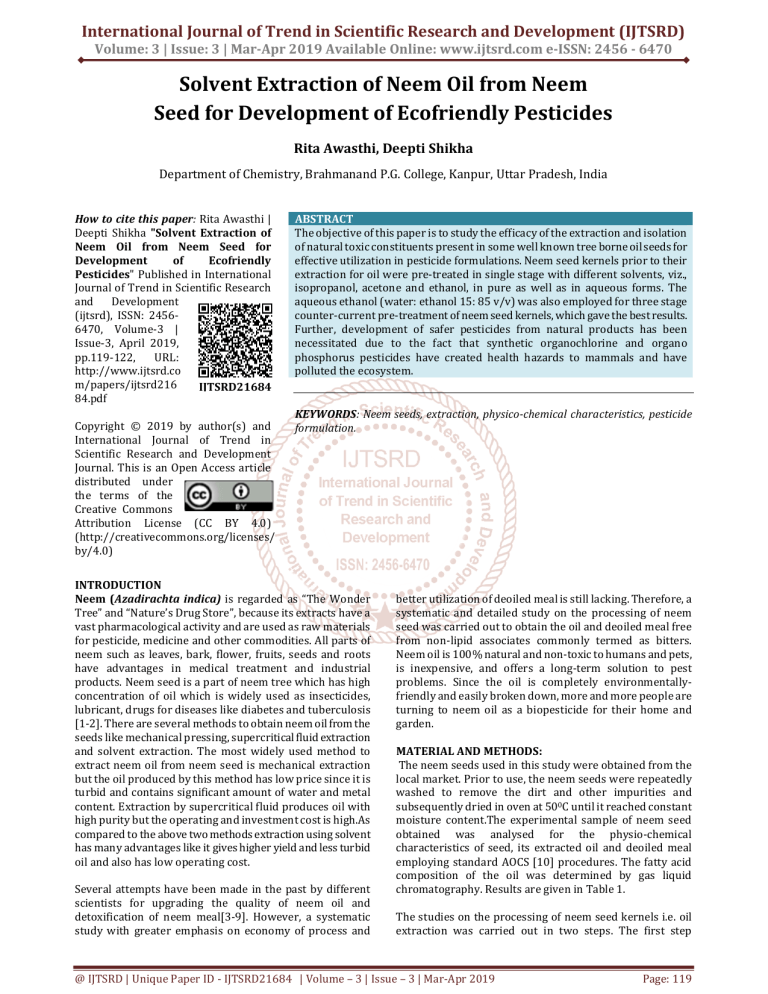
International Journal of Trend in Scientific Research and Development (IJTSRD)
Volume: 3 | Issue: 3 | Mar-Apr 2019 Available Online: www.ijtsrd.com e-ISSN: 2456 - 6470
Solvent Extraction of Neem Oil from Neem
Seed for Development of Ecofriendly Pesticides
Rita Awasthi, Deepti Shikha
Department of Chemistry, Brahmanand P.G. College, Kanpur, Uttar Pradesh, India
How to cite this paper: Rita Awasthi |
Deepti Shikha "Solvent Extraction of
Neem Oil from Neem Seed for
Development
of
Ecofriendly
Pesticides" Published in International
Journal of Trend in Scientific Research
and
Development
(ijtsrd), ISSN: 24566470, Volume-3 |
Issue-3, April 2019,
pp.119-122,
URL:
http://www.ijtsrd.co
m/papers/ijtsrd216
IJTSRD21684
84.pdf
Copyright © 2019 by author(s) and
International Journal of Trend in
Scientific Research and Development
Journal. This is an Open Access article
distributed under
the terms of the
Creative Commons
Attribution License (CC BY 4.0)
(http://creativecommons.org/licenses/
by/4.0)
ABSTRACT
The objective of this paper is to study the efficacy of the extraction and isolation
of natural toxic constituents present in some well known tree borne oil seeds for
effective utilization in pesticide formulations. Neem seed kernels prior to their
extraction for oil were pre-treated in single stage with different solvents, viz.,
isopropanol, acetone and ethanol, in pure as well as in aqueous forms. The
aqueous ethanol (water: ethanol 15: 85 v/v) was also employed for three stage
counter-current pre-treatment of neem seed kernels, which gave the best results.
Further, development of safer pesticides from natural products has been
necessitated due to the fact that synthetic organochlorine and organo
phosphorus pesticides have created health hazards to mammals and have
polluted the ecosystem.
KEYWORDS: Neem seeds, extraction, physico-chemical characteristics, pesticide
formulation.
INTRODUCTION
Neem (Azadirachta indica) is regarded as “The Wonder
Tree” and “Nature’s Drug Store”, because its extracts have a
vast pharmacological activity and are used as raw materials
for pesticide, medicine and other commodities. All parts of
neem such as leaves, bark, flower, fruits, seeds and roots
have advantages in medical treatment and industrial
products. Neem seed is a part of neem tree which has high
concentration of oil which is widely used as insecticides,
lubricant, drugs for diseases like diabetes and tuberculosis
[1-2]. There are several methods to obtain neem oil from the
seeds like mechanical pressing, supercritical fluid extraction
and solvent extraction. The most widely used method to
extract neem oil from neem seed is mechanical extraction
but the oil produced by this method has low price since it is
turbid and contains significant amount of water and metal
content. Extraction by supercritical fluid produces oil with
high purity but the operating and investment cost is high.As
compared to the above two methods extraction using solvent
has many advantages like it gives higher yield and less turbid
oil and also has low operating cost.
Several attempts have been made in the past by different
scientists for upgrading the quality of neem oil and
detoxification of neem meal[3-9]. However, a systematic
study with greater emphasis on economy of process and
better utilization of deoiled meal is still lacking. Therefore, a
systematic and detailed study on the processing of neem
seed was carried out to obtain the oil and deoiled meal free
from non-lipid associates commonly termed as bitters.
Neem oil is 100% natural and non-toxic to humans and pets,
is inexpensive, and offers a long-term solution to pest
problems. Since the oil is completely environmentallyfriendly and easily broken down, more and more people are
turning to neem oil as a biopesticide for their home and
garden.
MATERIAL AND METHODS:
The neem seeds used in this study were obtained from the
local market. Prior to use, the neem seeds were repeatedly
washed to remove the dirt and other impurities and
subsequently dried in oven at 500C until it reached constant
moisture content.The experimental sample of neem seed
obtained was analysed for the physio-chemical
characteristics of seed, its extracted oil and deoiled meal
employing standard AOCS [10] procedures. The fatty acid
composition of the oil was determined by gas liquid
chromatography. Results are given in Table 1.
The studies on the processing of neem seed kernels i.e. oil
extraction was carried out in two steps. The first step
@ IJTSRD | Unique Paper ID - IJTSRD21684 | Volume – 3 | Issue – 3 | Mar-Apr 2019
Page: 119
International Journal of Trend in Scientific Research and Development (IJTSRD) @ www.ijtsrd.com eISSN: 2456-6470
constituted the single-stage pre-treatment of the neem seed
kernels employing different solvents, viz., isopropanol,
acetone and ethanol, in pure and aqueous forms followed by
the second step, which constituted the subsequent extraction
of oil with n-hexane. The pre-treatment of crushed (10-30
mesh) neem seed kernels was carried out in laboratory scale
batch extractor by filling the material in a thimble placed in
the extractor with solvent keeping the seed to solvent ratio
of 1:3 w/v circulating hot water in extractor jacket to
maintain the temperature and keeping the material
immersed in the solvent for 8 hr.
After the completion of the extraction period, the solvent
extract was drained and solvent was distilled off. The nonlipid associates obtained were separated from oil by
extraction with petroleum ether followed by distillation of
ether to recover the oil which was analysed for its non-lipid
associates content. In the second step, the pre-treated
oilseed kernels obtained after the first step were
subsequently extracted with n-hexane to recover the
residual oil. The oil and meal thus obtained were analysed
for their content of non-lipid associates and other
characteristics.
The pre-treatment of neem seed kernels by the above
process was carried out, first with aqueous ethanol (water:
ethanol 15:85, v/v) at different temperatures varying
between 50-600C for 8 hr. The temperature of 550C was
found to be the optimum (Table 2). Further studies with
ethanol, acetone and isopropanol were carried out at the
pre-treatment temperature of 550C and for a period of 8 hr.
in the similar way. The oils recovered from the solvent
extracts and the deoiled meal were analysed as given before.
In the single stage process, aqueous ethanol (water: ethanol,
15:85 v/v) was considered to be optimum as it gave the best
results (Table 3).
Table 1: Characteristics of neem seed, crude oil and deoiled meal
Neem Seed, %
Kernel
46.8
Moisture
9.0
Oil Content
43.2
Total bitters contenta
5.5
Physio-chemical characteristics of crude neem oil
Sprcific Gravity, 300C
0.9083
Refracive Index, 400C
1.4622
Lovibond Colour (1cm cell)
30.0 Y+ 4.6 R + 1.0 B
Free fatty acid content
15.4
Iodine value
69.0
Saponification value
194.2
Bitters content, %
8.1 (3.5)b
Fatty acid Composition, %
Palmitic
17.9
Stearic
19.4
Oleic
49.9
Linoleic
12.8
Deoiled neem meal, %
Protein
33.7
Crude fibres
13.1
Moisture
12.5
Bitters
3.6 (2.04)b
Table 2(a): Effect of single stage pre-treatment of neem seeds with aq. ethanol on bitters content and other
characteristics of neem oil.
Bitters Content*
Temperature of
extraction 0C
50
55
60
Aq. Ethanol
extract %
3.4
3.6
3.5
Oil obtained from aq.
Solvent extract%
0.8
0.7
0.7
Oil obtd by hexane extract of
pretreated kernel %
0.67
0.62
0.71
Deoiled
meal %
0.61
0.61
0.61
Table 2(b): Effect of single stage pre-treatment of neem seeds on the characteristics of neem oil
Characteristics of oil
Oil obtained from aq.ethanol extract
Recovery*%
8.2
7.6
7.6
Lovibond colour
(1 cm cell)
FFA%
44
43
42
Y
R
B
30
30
30
7.4
7.0
7.6
2.0
2.0
2.4
Oil obtained by hexane extraction of pre-treated
neem kernels
Lovibond colour
(in 1 cm cell)
*
Recovery %
FFA%
Y
R B
34.1
35.6
35.5
7.1
7.0
7.9
@ IJTSRD | Unique Paper ID - IJTSRD21684 | Volume – 3 | Issue – 3 | Mar-Apr 2019
30
24
30
3
2
3
0.3
0.0
0.4
Page: 120
International Journal of Trend in Scientific Research and Development (IJTSRD) @ www.ijtsrd.com eISSN: 2456-6470
Table3: Effect of single-stage pre-treatment of neem seeds on bitter content of neem oil and deoiled meal
employing different aqueous solvents.
Bitters content*, %
Solvent:
Aqueous
Oil recovered
Oil recovered by
Solvents
Deoiled
Water
Solvent
from aqueous
hexane extraction of
Meal
ratio
extrace
ethanol extract
pretreated kernels
Aqueous
95:5
3.4
0.6
0.6
0.9
ethanol
85:15
3.6
0.7
0.6
0.6
75:25
3.5
0.6
0.7
0.7
+
50:50
3.1
-1.5
0.9
Aqueous
30:70
3.2
-1.5
0.8
Acetone
10:90
3.2
-1.6
0.7
75:25
1.4
1.5
0.8
1.8
Aqueous
50:50
2.8
1.1
0.9
0.7
isopropanol
40:60
3.1
0.8
1.0
0.6
RESULTS AND DISCUSSION:
Composition of experimental neem seed:
The experimental neem seed contained 46.8% kernels and
neem kernels contained 9.0% moisture, 5.5% non-lipid
associates (bitters) and 43.2% oil (Table 1). The high bitter
content of the kernel, if isolated could be of extensive use as
anti-bacterial agent, insect repellent and for other medical
purposes which have been extensively reported in the
literature [11-13]. For carrying out the present study, the
decorticated neem seed kernels obtained from experimental
neem seeds were utilised.
Physico-chemical characteristics of crude neem oil:
The analysis of the neem oil given in Table 1 indicates that
free fatty acid content of the oil is high (15.4%) which could
be probably due to longer storage of neem seeds before
being procured from market for extraction. The high bitter
content of the oil (8.1%) shows that about 63.2% of the total
bitters of neem seed kernels were extracted along with the
oil and the remaining 36.8% were left in and 12.8% linoleic
acid which indicated for edible use after proper processing.
Composition of deoiled neem meal:
The deoiled meal was found to contain 33.7% proteins,
13.1% crude fibres, 12.5% moisture and 3.6% non-lipid
associates (bitters) as shown in Table 1. Although the meal
was rich in proteins, the high content of bitters is a limiting
factor restricting its applications to only as organic manure.
Modified two-step process (single-stage pre-treatment):
The first step of the process i.e. the pre-treatment of neem
seeds kernels, was obviously considered as the critical step
since the second step was simply the extraction of the pretreated neem seed kernels with n-hexane by conventional
process. Thus, the parameters of the first step were varied
systematically to study their effect on the isolation of bitters
and reduction in the bitters content of the neem seed kernels
before extraction of oil with n-hexane.
The temperature of pre-treatment being the most important
parameter, its effect on the isolation of bitters and the
reduction of bitter content of deoiled meal and oil obtained
by n-hexane extraction was studied. Ethanol: water (85:15
v/v) was used as solvent at temperature ranging from 50 –
600C for 8 hr. The results depicted in Table 2 indicate that
550C was the optimum temperature at which maximum
amount of bitters could be extracted from neem seed
kernels.
The optimum recoveries of 4.3% bitters, out of 5,5%present
in seeds (table3) by aqueous ethanol (ethanol: water, 85:15
v/v), 3.2% by aqueous acetone (acetone:water,30:70) and
3.3% by isopropanol (isopropanol : water (40:60) indicated
that aqueous ethanol. (ethanol: water, 85:15 v/v)has better
efficiency. The bitter content of 0.6% in each of the oil
obtained by n-hexane extraction of aqueous ethanol
preheated neem kernels, and deoiled meal were also
minimum compared to the corresponding values of 1.5 and
0.8%,
respectively
by
aqueous
acetone
(acetone:water,50:50v/v) and 1.0 and 0.6% , respectively for
aqueous isopropanol (isopropanol : water (40:60v/v).This
further established the supremacy of aqueous ethanol
system (ethanol : water, 85:15 v/v) over other solvents. The
characteristics of oils obtained from aqueous solvents
extract and from the preheated neem seed kernels shown in
table 4 also indicate a superior efficacy of aqueous ethanol
(ethanol : water, 85:15 v/v) system.
Although, the aqueous ethanol treatment considerably
reduced the bitter content in the oil and deoiled meal, the
reduction was still considered to be insufficient. To further
reduce these bitter contents, the pre-treatment was carried
out in three-stage counter-current manner in place of a
single-stage.
Alcohol extracts contain certain value added products, e.g.
non-lipid associates (bitters), colouring matter and light
coloured mixed fatty acids. The oil extracted after pretreatment may be used as edible oil. Seeds with high FFA oil
due to prolonged storage may also be processed for
production of good quality oil. Meal with higher nutritive
value, free from bitters and odoriferous materials may be
produced. The active ingredient azadiractin acts as a very
active insect phagorepellent and systematic growth
disruptor. It is a natural herbal product which is fully biodegradable.
Table 4: Properties of active ingredient azadiractin for
pesticide formulation
Azadiractin (C 35 H44 O16); Mol
Active
wt: 720
ingredient:
microcrystalline pale yellow
Physical
coloured crystals from
properties:
petroleum ether.
Odour:
Neem like
Appearance:
Oily
Colour:
Dark brown
Specific gravity: 1.02 at 25o C
Sprayability:
Easily sprayable
Hazards:
Non-hazardous in every way
Viscosity
Twice than that of water.
@ IJTSRD | Unique Paper ID - IJTSRD21684 | Volume – 3 | Issue – 3 | Mar-Apr 2019
Page: 121
International Journal of Trend in Scientific Research and Development (IJTSRD) @ www.ijtsrd.com eISSN: 2456-6470
PESTICIDE FORMULATION
Azadiractin, works by interrupting the reproductive cycle of
insects. Once ingested, it affects the hormonal system of the
insect, causing it to forget to eat and stop moulting, mating
and laying eggs.This eventually sees the complete
destruction of the insect population in the designated area as
the older insects die off without producing offspring.Neem
oil is also powerfully aromatic and gives off an odour that
insects do not like, protecting plants by making them
unappealing. Pesticide can be formulated in the following
steps:
A base of good-quality: 100% pure neem oil is needed
which is cold pressed as head destroys the Azadirachtin.
Neem oil ensures no contamination of solvents has
taken place during the purification process.
Emulsification: Neem oil does not readily mix with
water therefore an emulsifier like a mild liquid soap has
been used.
Preparation of mixture: In order to make a litre of
neem oil spray, 5 ml of neem oil, 2 ml of liquid soap and
1 litre of water is mixed. Soap is added to water first and
then slowly neem oil is mixed with continuous stirring.
Spray: The mixture is collected into a spray
bottle which is ready to use as an effective pesticide.
CONTRIBUTION TO THE SOCIETY:
Eco-friendly literally means earth-friendly or not harmful to
the environment . This term most commonly refers to
products that contribute to green living or practices that
help conserve resources like water etc. Eco-friendly products
also prevent contributions to air, water and land pollution.
For many years, we have enjoyed the benefits of
using pesticides to control weed, insect, fungus, parasitic,
and rodent pests. Recently, both the public and the press
have increasingly focused on the negative impacts of
agricultural, urban industrial, and residential chemicals.
However, there are also substantial benefits to society,
including:
Pesticides are the only effective means of controlling
disease organisms, weeds, or insect pests in many
circumstances.
Consumers receive direct benefits from pesticides
through wider selections and lower prices for food and
clothing.
Pesticides protect private, public, and commercial
dwellings from structural damage associated with
termite infestations.
Pesticides contribute to enhanced human health by
preventing disease outbreaks through the control of
rodent and insect populations.
Pesticides are used to disinfect indoor areas (e.g.,
kitchens, operating rooms, nursing homes) as well as
dental and surgical instruments.
The pesticide industry also provides benefits to society.
CONCLUSION:
Pesticides contamination pose significant risks to the
environment and non-target organism ranging from
beneficial soil microorganism, to insects, plants, fish and
birds. The best way to reduce pesticide contamination in our
environment is for all of us to do our part to use safer, nonchemical pest control methods. With the knowledge of
synthetic pesticides, worldwide attention is rapidly shifting
to non-synthetic, safe pesticides. Neem extract – pesticide
formulation is a water based formulation of a biological
material which mainly contain an active ingredient
Azadiractin which acts as a very active insect phagorepellent
and systematic growth disruptor. It is a natural herbal
product which is fully bio-degradable. Pesticides are often
considered a quick, easy and inexpensive solution for
controlling weed and insect pest in urban landscapes. It has
contaminated almost every part of our environment and
residues are found in soil, air, surface and ground water.
REFERENCES:
[1] Puri, H,S.Neem-The Divine Tree Harwood Academic
Publisher, Amsterdam (1999).
[2] Ragasa,C.Y., Nacpil,Z.D., Natividad,G.M., Tada,M., Coll.J.C.
and
Rideout,J.A,
Tetranortriterpenoids
from
Azadirachta Indica., Journal of Phytochemistry,46,555
(1997).
[3] Warden, C.D., Forest Resources of the Baroda State,
Baroda Printing Works, Baroda, Bull.2, 2nd Ed., 10
(1921).
[4] https://www.sciencedirect.com/science/article/pii/S1
872203218301641 (2018)
[5]
Godrej, N.B., J. Oil Tech. Assocn. Of India, 14, 39 (1982).
[6] Kane, J.G., Rao, V.R. and Subrahmanyam V.V.R., J. Oil
Technol. Assocn. Of India, 5, 59, (1973).
[7] Mitra, C.R., Indian Oilseeds J., 1, 256 (1957).
[8] Siddiqui, S. and Mitra, C.R., Indian Patents, 33, 649
(1946), 33, 650 (1946), 33, 651 (1946).
[9] Sinha, N.P. and Gulati, K.C., Abstr., Second Indian
Oilseeds Res. Workers Conference, Indian Central
Oilseeds Committee (1961).
[10] Official and Tentative methods, American Oil Chemists’
Society, Champaign, Illinois, (1973).
[11] Chatterjee, A.K. and Roy, C., Ind. J. of med. Res., 5, 656
(1917).
[12] Sinha, K.C., Riar, S.S. and Vardhan J., Indian J. Med. Res.,
131 (1984).
[13] http://npic.orst.edu/ingred/ptype/natbio.html (2018)
@ IJTSRD | Unique Paper ID - IJTSRD21684 | Volume – 3 | Issue – 3 | Mar-Apr 2019
Page: 122

